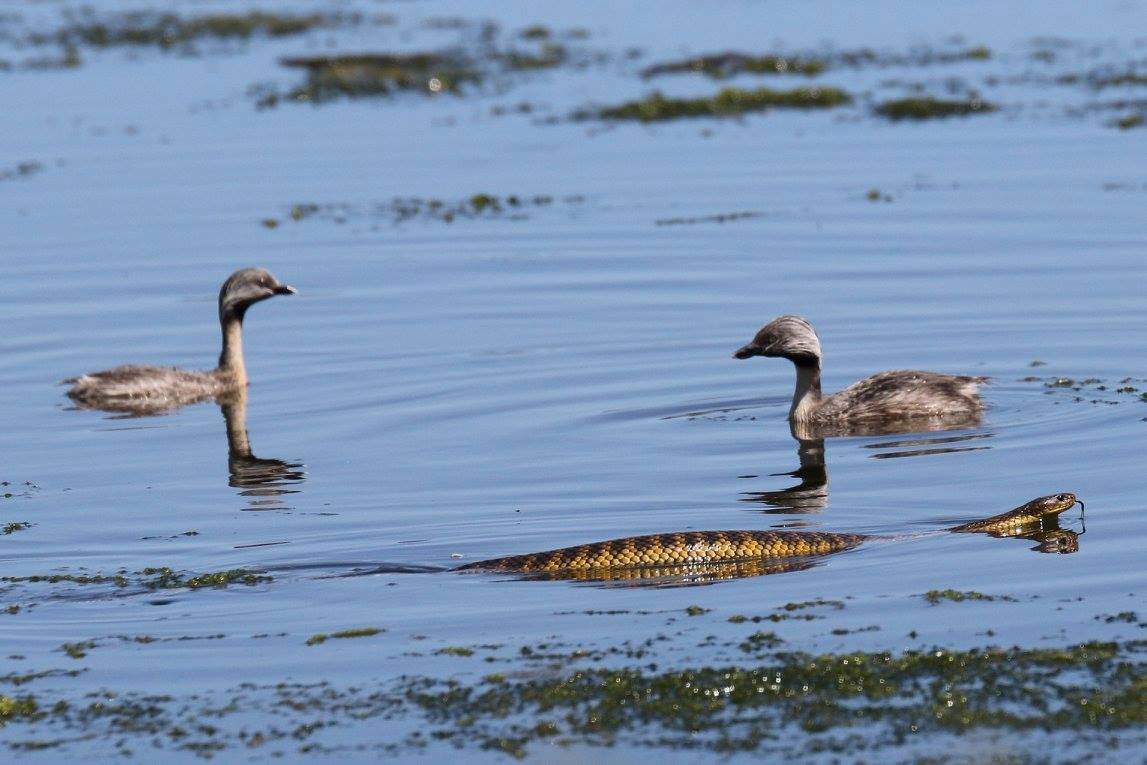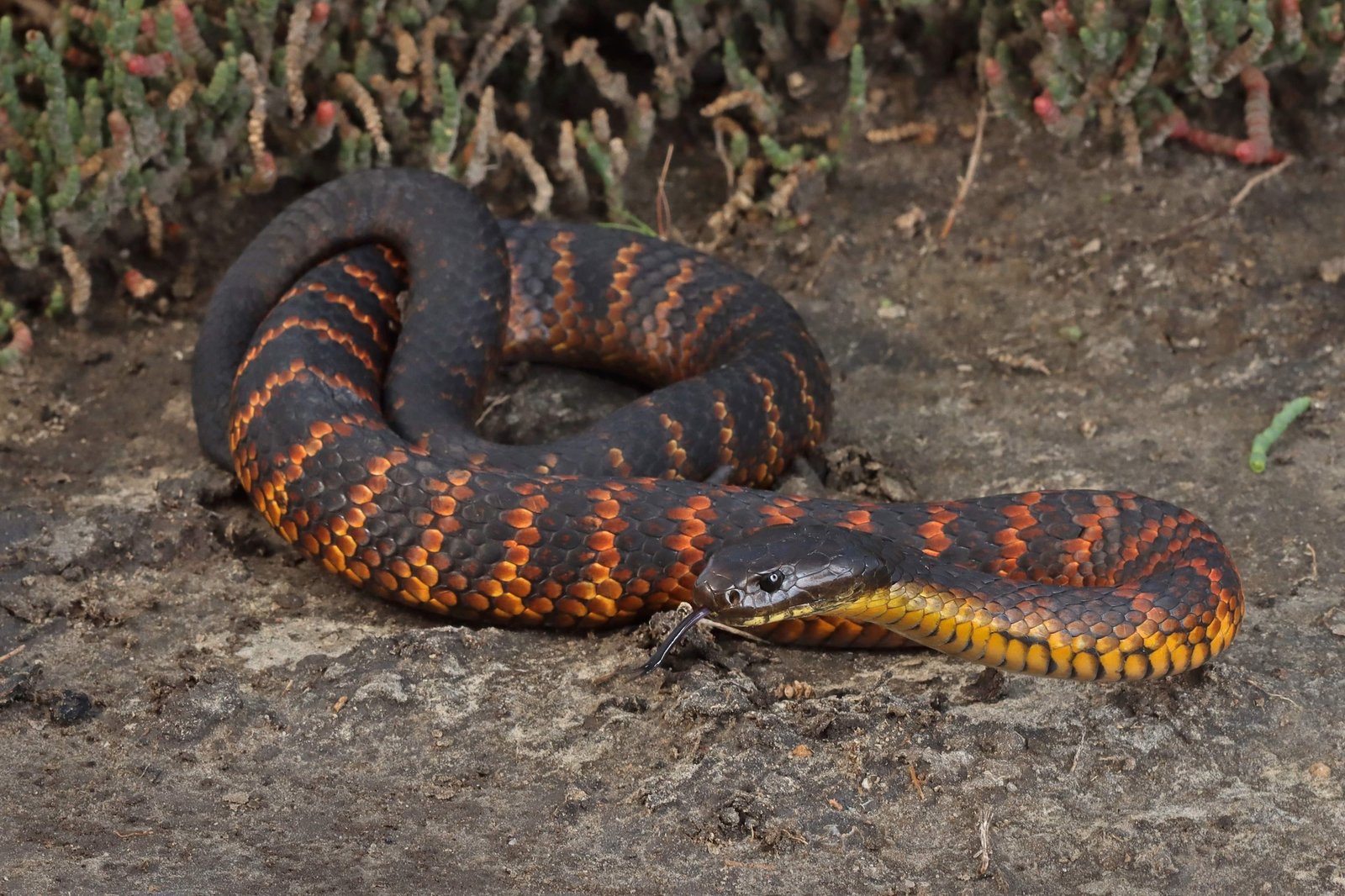Tiger Snake
Large banded individuals are fairly distinct and unlikely to be confused with anything else, except perhaps a banded form of Eastern Brown Snake Pseudonaja textilis. Juveniles could be mistaken for the Rough-scaled Snake Tropidechis carinata, or a Stephen’s Banded Snake Hoplocephalus stephensii. Patternless tiger snakes may resemble several other venomous snakes, e.g. Copperheads Austrelaps spp., Black Snakes Pseudechis spp.On Kangaroo Island, some specimens have a reddish belly, which has led them to be misidentified as Red-bellied Black Snakes Pseudechis porphyriacus.
Introduction
Most Australians know of tiger snakes and are aware of their fearsome reputation, though few people will ever encounter one. Unfortunately this species is much maligned because of its aggressive nature and toxic venom; however the tiger snake should be recognised as a great survivor, superbly adapted to some of the most inhospitable environments in Australia.
What do Tiger Snakes look like?

© CC BY-NC 4.0
Identification
In the past, two species of tiger snakes were commonly recognised: the Eastern Tiger Snake Notechis scutatus, and the so-called Black Tiger Snake Notechis ater. However, morphological differences between the two appear inconsistent, and recent molecular studies have shown N. ater and N. scutatus to be genetically similar, hence it would seem that there is now just one wide-ranging species that varies greatly in size and colouration – Notechis scutatus.
Despite this recent revision, the old classification is still in popular use and a number of subspecies are also recognised:
- Notechis ater ater – Krefft’s Tiger Snake (Flinders Ranges, South Australia)
- Notechis ater humphreysi – Tasmanian Tiger Snake (King Is. and Tasmania)
- Notechis ater niger – Peninsular Tiger Snake (lower Eyre and Yorke Peninsulas, offshore islands of South Australia)
- Notechis ater serventyi – Chappell Island Tiger Snake (Furneaux Group, Bass Strait)
- Notechis scutatus occidentalis (sometimes N. ater occidentalis) – Western Tiger Snake (southwest corner of Western Australia)
- Notechis scutatus scutatus – Eastern Tiger Snake (southeastern mainland Australia)
The common name refers to the prominent yellow and black cross-bands typical of some populations of tiger snakes, however not all have this pattern. The most commonly seen form is dark olive brown to blackish-brown, with off-white to yellowish cross-bands that can vary in thickness. Entirely patternless individuals may occur in banded populations, and these types range in colour from yellowish-brown to black. Some populations consist of almost entirely unbanded individuals, e.g. those of the central highlands and southwest of Tasmania. Melanism (dark body colouration) is most strongly developed in populations exposed to highly variable weather conditions and cool extremes, such as those experienced at higher altitudes or on offshore islands. The dark colouration is an adaptation that allows those snakes to absorb heat at a faster rate during the short growing season.
The head is moderately wide and deep and only slightly distinct from the robust, muscular body. The neck and upper body can be flattened to a considerable degree when performing a threat display, exposing the black skin between the relatively large, semi-glossy scales.
Midbody scales 17-21 rows, ventral scales 140-190, single anal and subcaudal scales. A large squarish frontal shield, not or scarcely longer than broad, is characteristic of Notechis.
Where do Tiger Snakes live?
Habitat
The species is often associated with watery environments such as creeks, dams, drains, lagoons, wetlands and swamps. They can also occur in highly degraded areas e.g. grazing lands, especially where there is water and local cover. Tiger snakes will shelter in or under fallen timber, in deep matted vegetation and in disused animal burrows. Unlike most other Australian elapids, tiger snakes climb well on both vegetation and human constructions, and have been found as high as 10 m above the ground.
Altitudinally, tiger snakes range from sea level to above 1000m (Tasmania).

Tiger Snakes are often found in watery environments such as creeks, dams, drains, lagoons, wetlands and swamps.
Image: Chris Barnesoz© CC BY-NC 4.0
Distribution
Tiger snakes have a non-continuous distribution within two broad areas; southeastern Australia (including the islands of Bass Strait and Tasmania), and southwestern Australia.
Populations occur on the following offshore islands; (counter-clockwise around Australia) Carnac and Garden (Western Australia); Goat, West Franklin and East Franklin in Nuyts Archipelago; Hopkins; Hareby; Reevsby, Marum, Partney, Lusby, Roxby and Spilsby in the Sir Joseph Banks Group; Kangaroo (South Australia); New Year, Christmas and King in western Bass Strait and Badger, Mt Chappell, Flinders, Babel and Cat in eastern Bass Strait (Tasmania). It is not clear whether the population on Carnac Island is of completely indigenous origin or not, as some 80 individuals were released on the island in around 1929 without record of them already being present.
What do Tiger Snakes eat?
Feeding and diet
Tiger snakes in the wild have a broad diet that includes fish, frogs and tadpoles, lizards, birds and mammals, as well as carrion. As the size of the snake increases, so to does the average prey size, however this increase is achieved not by larger snakes giving up on small prey but by them taking more large prey. Tiger snakes are largely diurnal and hunt for prey during the daylight hours; however they will forage on warm evenings. They will readily search underwater and can stay under for at least 9 minutes. A bat was found in the stomach of one museum specimen, demonstrating the tiger snake’s ability to climb. Invertebrates have also been found in tiger snake stomachs however these could have been taken as part of carrion; other taxa such as grasshoppers and moths however may have been ingested as prey. Cannibalism amongst wild tiger snakes has also been reported. Prey items are grasped and subdued quickly by the powerful venom, with sometimes constriction being employed as well.
Available prey size is thought to play an important role in dictating the adult size of tiger snakes in some island populations. For example, on Chappell Island the snakes are typically very large and take advantage of the seasonal abundance of fat muttonbird chicks, whereas on Roxby Island where there are no nesting seabirds the dwarf population of snakes survive on mostly small skinks.

© CC BY 4.0
Specimen in our collection
View microCT scans of a Tiger snake (Notechis scutatus) from the Australian Museum Herpetology Collection (specimen AM R.81661). Learn more about microCT scanning and how it is used by the Australian Museum Research Institute.
How do Tiger Snakes mate?
Breeding behaviours
In southwestern Australia, females are mature at a snout-vent length of at least 763 mm. On the main island of Tasmania, males can be mature at a mass of 500g and females can be mature at a snout-vent length of 850mm and a mass of at least 325g.
At the beginning of the breeding season males engage in combat that involves each of the two combatants trying to press down the head of the other and generally results in the snakes becoming partially intertwined. Mating has been reported to occur in late summer (March), but it is not clear whether this observation occurred in the wild or in captivity. Such late season mating is advantageous for southern species, giving them a reproductive head-start before spring. On the main island of Tasmania, mating has been observed lasting as long as seven hours. Gravid females may be relatively sedentary, with one gravid female in Tasmania reportedly remaining at its "homesite" for 50 days. In southwestern Australia, females give birth to live young (ovoviviparous) between late summer and mid-autumn (17 March-18 May). Litter size ranges from 10 to 64. The young are born in a membranous sac and once they break free they are totally independent.
Seasonality
Snakes are typically more active during the warmer months, however tiger snakes may also be found out basking on warm winter days. During cool periods they will aestivate in animal burrows, under large boulders and in standing dead trees, and may go as deep as 1.2m underground. As many as 26 neonates, perhaps all from one late season litter, have been found together in a winter shelter.

© CC BY 4.0
Are Tiger Snakes endangered?
Conservation status
Flinders Ranges population (as Notechis ater ater) is listed as vulnerable (Commonwealth, IUCN).
Chappell Island population (as Notechis ater serventyi) is listed as vulnerable (Tasmania).
Predators
The known predators of tiger snakes include the elapid snake Cryptophis nigrescensand certain birds of prey such as butcherbirds, goshawks, harriers, ibises, kites and kookaburras. In one survey taken on Carnac Island, a high proportion of the tiger snakes were blind in one (6.7 percent) or both eyes (7.0 percent) due the attacks by nesting gulls. While this is not predation per se, it does increase the catchability of the snakes by human hunters and hence probably increases the chances of their being taken by non-human predators. Tiger snakes have also been heavily persecuted by humans in the past and are still routinely killed when encountered. Many also become road victims.
Tiger snake are known to be parasitized by ticks, cestodes (tape worms), nematodes (round worms), pentastomids (tongue worms), and trematodes (flukes).

The Kookaburra is a known predator of the Tiger Snake.
Image: Frank Yuwono© CC BY-NC 4.0
Are Tiger Snakes dangerous to humans?
Danger to humans
The snake's large size, often aggressive defence and toxic venom make it extremely dangerous to humans. Although generally shy and preferring escape over conflict, a cornered tiger snake will put on an impressive threat display by holding its forebody in a tense, loose curve with the head slightly raised and pointed at the offender. It will hiss loudly as it inflates and deflates its body, and if provoked further will lash out and bite forcefully. The venom of the tiger snake is strongly neurotoxic and coagulant, and anyone suspected of being bitten should seek medical attention immediately.
Evolutionary relationships
The present-day fragmented distribution of tiger snakes is due to a combination of geologically recent climatic changes (increasing aridity) and sea-level changes (islands cut off from the mainland in the past 6000-10000 years). Populations isolated through these events have undergone changes in their colour patterns, size and ecology in response to various environmental pressures.
References
- Cogger, H. (2000) “Reptiles and Amphibians of Australia”, Reed New Holland
- Greer, A.E. (2006) “Encyclopedia of Australian Reptiles : Elapidae”, Australian Museum
- Ehmann, H. (1992) “Encyclopedia of Australian Animals : Reptiles”, Australian Museum, Angus & Robertson
- Mirtshin, P. and Davis, R. (1991) “Dangerous Snakes of Australia”, revised edition, Ure Smith Press
- Wilson, S. and Swan, G. (2008) “A Complete Guide to Reptiles of Australia”, Reed New Holland


